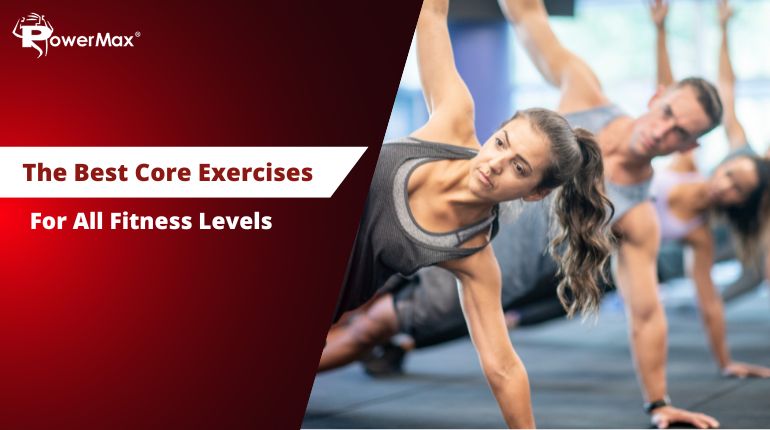When it comes to fitness, a strong core is essential. It provides stability, improves posture, and enhances overall physical performance. Whether you are a beginner just starting your fitness journey or an experienced athlete, incorporating core exercises into your routine is key to achieving a balanced, strong body. Explore some of the best core exercises suitable for all fitness levels.
Why Core Strength Matters
Your core muscles include the abdominal muscles, obliques, lower back muscles, and pelvic floor. These muscles work together to stabilize your spine and pelvis, enabling smooth movement and reducing the risk of injury. A strong core also improves balance, coordination, and power. From everyday tasks like lifting groceries to high-intensity sports, core strength plays a pivotal role in your overall functional fitness.
Now, let’s dive into the best exercises for building a robust core, categorized by fitness level.
Beginner Core Exercises
If you’re new to fitness, foundational movements are a great starting point.
Modified plank
One such exercise is the modified plank. Begin on your hands and knees, lower your forearms to the ground, and step your feet back to create a straight line from your head to your knees. Focus on engaging your core and holding the position for 20-30 seconds, gradually increasing the time as your strength improves. This simple exercise is excellent for enhancing stability and posture.
Dead bug
Another effective beginner move is the dead bug. Lie on your back with your arms extended toward the ceiling and your knees bent at a 90-degree angle. Lower your right arm and left leg simultaneously, keeping your core engaged, then return to the starting position and repeat on the opposite side. This movement not only strengthens your core but also improves coordination and protects your lower back.
Bird-dog
Finally, try the bird-dog exercise to enhance balance and stability. Start on your hands and knees, extend your right arm and left leg simultaneously, and keep your back flat while engaging your core. Switch sides and repeat. These beginner exercises are gentle but effective, setting a solid foundation for more challenging core workouts.
Intermediate Core Exercises
Once you’ve built a good base of strength, it’s time to step up the challenge.
Standard Plank
The standard plank is a great progression from the modified version. Position your forearms on the floor and extend your legs behind you, forming a straight line from head to heels. Engage your core and hold for 30 to 60 seconds, focusing on maintaining proper form to maximize the benefits.
Russian twists
For a dynamic twist, try Russian twists. Sit on the floor with your knees bent, lean back slightly, and lift your feet off the ground. Holding a weight or medicine ball, twist your torso from side to side. This exercise strengthens the obliques and enhances rotational strength, making it an excellent addition to your core routine.
Leg raises
Leg raises are another intermediate move that targets the lower abs. Lie flat on your back with your legs extended, then lift them toward the ceiling while keeping your lower back pressed into the floor. Slowly lower your legs back down, maintaining control throughout the movement. These exercises provide a well-rounded approach to core training for intermediate fitness enthusiasts.
Advanced Core Exercises
For those seeking even greater challenges, advanced core exercises offer complexity and increased resistance
Side planks
Side planks with leg lifts are a powerful variation. Lie on your side with your forearm on the ground and feet stacked. Lift your hips to create a straight line, then raise your top leg without bending the knee. This move works the obliques, glutes, and overall stability.
Hanging leg raises
Hanging leg raises are perfect for targeting the lower abs with added intensity. Hang from a pull-up bar with your arms fully extended. Keep your legs straight and lift them toward your chest, then lower them back down slowly. This exercise not only builds core strength but also enhances grip and upper-body control.
Ab wheel rollout
Another advanced favorite is the ab wheel rollout. Kneel on the floor with an ab wheel in both hands. Slowly roll the wheel forward, extending your body as far as possible without compromising form, then pull back to the starting position. This move engages the entire core, including deep stabilizer muscles, making it a staple for advanced core training.
Tips for Maximizing Core Workouts
When working on your core, always focus on maintaining proper form. Drawing your navel toward your spine helps activate your abdominal muscles effectively. Remember to breathe properly, exhaling during exertion to stabilize your core and maintain control. Incorporating a variety of exercises keeps your routine dynamic and ensures you target all areas of your core.
Conclusion
A strong core is the foundation of a healthy, functional body. By incorporating exercises tailored to your fitness level, you can build strength, stability, and endurance over time. Progress gradually, maintain proper form, and stay consistent to reap the full benefits of core training. Whether you’re aiming for improved athletic performance, better posture, or reduced risk of injury, these core exercises will help you achieve your fitness goals.
 India (INR)
India (INR)
 UAE (AED)
UAE (AED)
 Store Locator
Store Locator



-thumb.jpg)
-thumb.jpg)
-thumb.jpg)
-thumb.jpg)
-thumb.jpg)
-thumb.jpg)
-thumb.jpg)

-thumb.jpg)
-thumb.jpg)